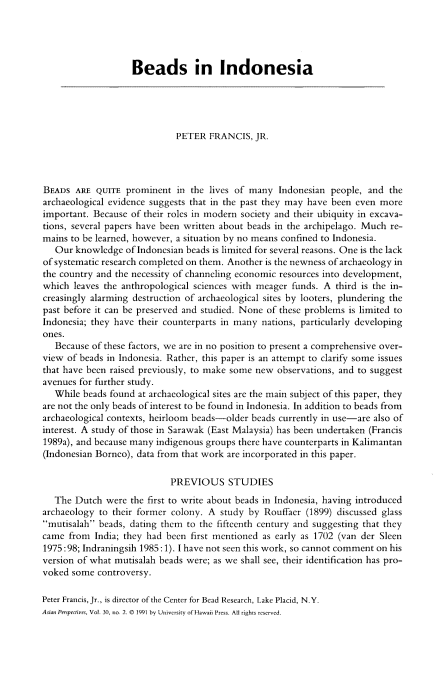|
|
|
|---|

| ชื่อผู้แต่ง | Peter Francis, Jr. |
| วารสาร/นิตยสาร | Asian Perspectives |
| ปี | 1991 |
| ปีที่ | 30 |
| ฉบับที่ | 2 |
| หน้าที่ | 217-241 |
| ภาษา | English |
BEADS ARE QUITE prominent in the lives of many Indonesian people, and the archaeological evidence suggests that in the past they may have been even more important. Because of their roles in modern society and their ubiquity in excavations, several papers have been written about beads in the archipelago. Much remains to be learned, however, a situation by no means confined to Indonesia.
Our knowledge of Indonesian beads is limited for several reasons. One is the lack of systematic research completed on them. Another is the newness of archaeology in the country and the necessity of channeling economic resources into development, which leaves the anthropological sciences with meager funds. A third is the increasingly alarming destruction of archaeological sites by looters, plundering the past before it can be preserved and studied. None of these problems is limited to Indonesia; they have their counterparts in many nations, particularly developing ones.
Because of these factors, we are in no position to present a comprehensive overview of beads in Indonesia. Rather, this paper is an attempt to clarify some issues that have been raised previously, to make some new observations, and to suggest avenues for further study. While beads found at archaeological sites are the main subject of this paper, they are not the only beads of interest to be found in Indonesia. In addition to beads from archaeological contexts, heirloom beads --older beads currently in use-- are also of interest. A study of those in Sarawak (East Malaysia) has been undertaken (Francis 1989a), and because many Indigenous groups there have counterparts in Kalimantan (Indonesian Borneo), data from that work are incorporated in this paper.
Indonesian beads
stone beads
Mutisalah, the Bahasa Indonesian/Bahasa Malay word for "false pearl"
Java Beads
glass beads
Heirloom beads

BEADS ARE QUITE prominent in the lives of many Indonesian people, and the archaeological evidence suggests that in the past they may have been even more important. Because of their roles in modern society and their ubiquity in excavations, several papers have been written about beads in the archipelago. Much remains to be learned, however, a situation by no means confined to Indonesia.
Our knowledge of Indonesian beads is limited for several reasons. One is the lack of systematic research completed on them. Another is the newness of archaeology in the country and the necessity of channeling economic resources into development, which leaves the anthropological sciences with meager funds. A third is the increasingly alarming destruction of archaeological sites by looters, plundering the past before it can be preserved and studied. None of these problems is limited to Indonesia; they have their counterparts in many nations, particularly developing ones.
Because of these factors, we are in no position to present a comprehensive overview of beads in Indonesia. Rather, this paper is an attempt to clarify some issues that have been raised previously, to make some new observations, and to suggest avenues for further study. While beads found at archaeological sites are the main subject of this paper, they are not the only beads of interest to be found in Indonesia. In addition to beads from archaeological contexts, heirloom beads --older beads currently in use-- are also of interest. A study of those in Sarawak (East Malaysia) has been undertaken (Francis 1989a), and because many Indigenous groups there have counterparts in Kalimantan (Indonesian Borneo), data from that work are incorporated in this paper.
Indonesian beads
stone beads
Mutisalah, the Bahasa Indonesian/Bahasa Malay word for "false pearl"
Java Beads
glass beads
Heirloom beads